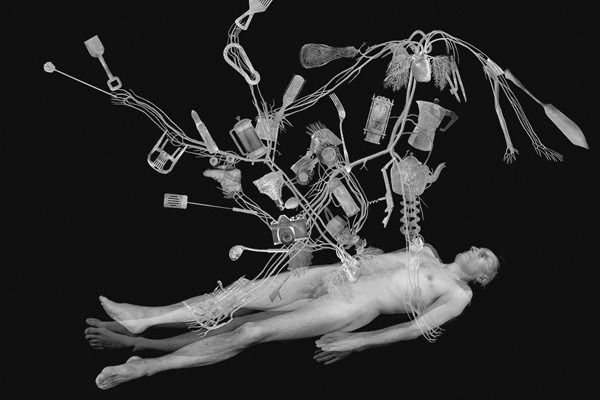
As Marta de Menezes, a biology-influenced artist who creates new forms of butterflies, puts it evocatively, “We are witnessing the birth of a new form of art: art created in test tubes, using laboratories as art studios.”
Biology-influenced art was the next major artsci movement to emerge after computer art, kick-started with the help of a great deal of funding from the Wellcome Trust. It has really hit its stride in the twenty-first century. Biology is the science of life. Of all the sciences, biology touches us all most immediately. While other science-influenced art movements can expand our horizons and inspire us, biology-influenced art has the potential actually to affect our lives.
Biology-inspired art dates back some 32,000 years, ever since humans first picked up a piece of charcoal and drew an animal on a cave wall, and reappears in the works of Leonardo. It’s old, yet new, for the modern-day art movement involves collaborations between artists and scientists, making up-to-date research tools available to the artist.
Unraveling the structure of DNA in 1953 was the greatest scientific discovery of the twentieth century, with its potential to cure disease and alter life forms through genetic engineering. Metaphors abound to make the new biology understandable: that blood flows through vessels like a liquid through pipes, that the heart acts like a mechanical pump, that ions flow through cell walls like particles through a mesh, and that the mind is a digital computer. And biology is, of course, of more immediate relevance than exotic subjects such as supernovas or Schrödinger’s cat, simultaneously dead and alive. Moreover, artists have been welcomed into biology laboratories to work alongside scientists.
Biology-influenced artists have at their disposal objects like organs, that can actually be glimpsed by cutting open the body or using functional magnetic resonance imaging (ƒMRI), or like cells that can be seen with microscopes. In contrast, physics depends on visual images generated by mathematical models to provide a glimpse of unimaginable objects such as black holes, while observing the heavens with the naked eye reveals only dots of light twinkling on a vast canopy. In biology-influenced art, the object of study can actually be altered by artists exploring the boundaries between humans, animals, and robots, working alongside scientists.
Artists can even genetically engineer new forms of life in sterile conditions, in vitro, or in bioreactors (devices that maintain the optimum conditions for growth). Their startling experiments on objects that straddle the border between living and nonliving remind us that in the long course of our evolutionary history we come from—and still have within us—organisms other than human.
Science is changing our world and our lives at an ever-increasing rate. Today artists are bringing science out of the laboratory.
Art & Science: merging art and science
to make a revolutionary new art movement
In 2011 I co-curated a show at GV Art in London entitled Art & Science: Merging Art & Science to Make a Revolutionary New Art Movement. My co-curator was Robert Devcic, the dynamic owner of GV Art, which at the time specialized in biology-influenced art. Instead of the usual minimalist title for an exhibition, we chose a longer, more challenging one to reflect the debates swirling around this new art movement. Most of the artists in the show collaborate with scientists and the benefits sometimes run in both directions. Their works explore the meaning of life and our bodies and of systems on the boundary between living and nonliving.

7.1: Andrew Carnie, In Out, 2008.
Artists in the laboratory often produce works of considerable interest to scientists. Andrew Carnie plays with the notion of how our view of the human body is mediated by science. In Out is an exploration of how our sense of self is disrupted when a foreign body such as a heart is inserted into us. How does awareness of such an invasive event affect our perception of who we are? Carnie claims that “art is too important to be left to artists—science too important to be left to scientists.”
David Marron has a different take on biology-inspired art. As a paramedic he ponders the body in death, whether from violence, accident, or natural causes, sometimes in the loneliest of circumstances. For our exhibition he created an extraordinary shamanic figure that he calls The Physician, with a birdlike head and proboscis-like nose that he says was inspired by a stethoscope, a chest that doubles as a medicine cabinet, and a long blue hospital robe. It’s oddly dignified and imposing and certainly unforgettable. “Each work is approached differently but a generalized underlying subject is humanity, scratching at our fragility and durability, violence and emotion—our habits,” he explains.
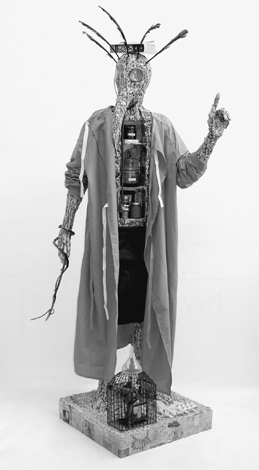
7.2: David Marron, The Physician, 2011.
These artists explore, interpret, and reinterpret forms in nature, attempting to identify forms that are successful and find out what makes them so. Davide Angheleddu describes his investigations thus: “My artistic production gets inspiration from nature, particularly from nature sublimely described in the book Kunstformen der Natur (Art Forms in Nature) by the German philosopher and biologist Ernst Haeckel.” To investigate the essence of natural forms, he produces crisp, perfect, organic shapes using digital technologies to sculpt.
Katharine Dowson is inspired by the way that science and technology can inform us about the hidden world of the human body, beyond even what we can see in anatomy museums. She uses laser technology to work with transparent materials, particularly glass, because it is “a major component in scientific discovery, from test tubes to lenses, revealing the microcosmic and macrocosmic universe and their visual similarities.” She makes amazingly fine sculptures of the brain and the vascular system. In Dowson’s Memory of a Brain Malformation, the blood vessels from a cerebral angiogram of her cousin’s brain have been etched by laser into glass. It depicts a tumor that was later removed by laser, which was also the means for creating the work.
Ken and Julia Yonetani look to the environment for inspiration and use salt or sugar mixed with water to make extraordinary sculptures of anything from a still life as perfect as something in an old master painting to a salt mountain, an image of human veins, or a map of the world. “Our work tries to retrace lines of connections that have been broken or lost, particularly between acts of consumption and the environment,” they write.
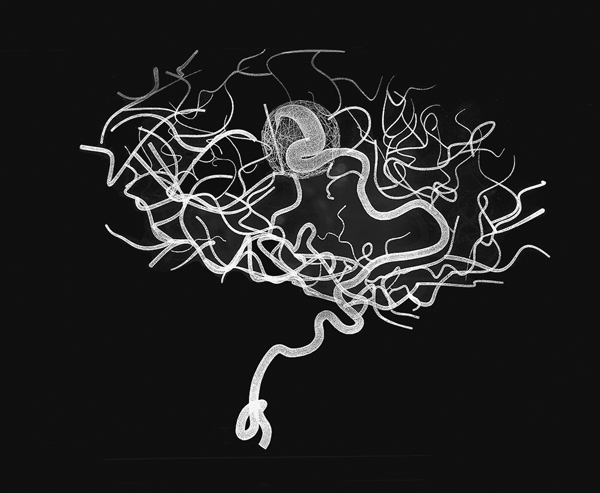
7.3: Katharine Dowson, Memory of a Brain Malformation, 2006.
Susan Aldworth works on the border between philosophy of mind and neurophysiology. She studies the relationship of the self to the physical brain, “how to define one’s personality and whether it can be physically located.” Among her tools is ƒMRI. For the piece in our show she took twenty prints of a scan of her own brain, then scratched sketches on them and added text, so that the “scan might look like it could show what was going on in my imagination as well as the physical structure and function of my brain.” She called the work Cogito Ergo Sum 3. While the scan reveals the brain’s physical structure and function, it does not tell you anything about the self, she points out. “Where am I in those pictures?” she asks. “You will look into my brain but you will never find me.”
Annie Cattrell too looks into the self. She contributed Pleasure and Pain, created in collaboration with Morton Kringelbach, an eminent neuroscientist. They used ƒMRI to study the region in the brain stem that responds to pleasure and pain, then, using rapid prototyping, a technique akin to a three-dimensional print, Cattrell made a model of the brain stem to show its oscillations. The resulting sculpture, made of resin, is beautiful as well as interesting. As Martin Kemp, the art historian, put it in a review in Nature, it “invites analogies—an incredibly complicated vertebra perhaps, or a wondrous fungal growth, or even a blossom flowering posthumously in the scalding water of a teapot.”

7.4: Susan Aldworth, Cogito Ergo Sum 3, 2006.
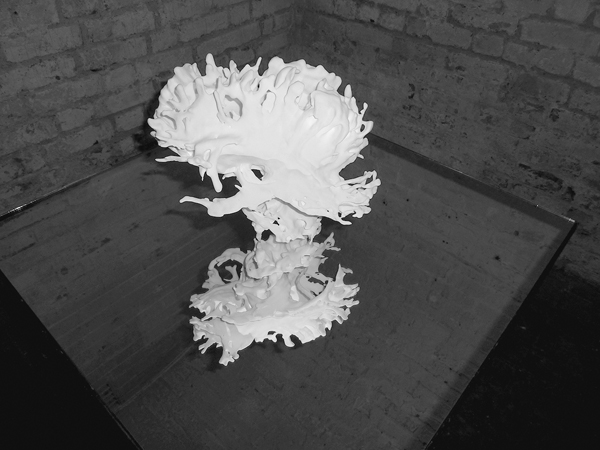
7.5: Annie Cattrell, Pleasure and Pain, 2010.
What we see is a very precise depiction of how the mind actually responds to pleasure and pain. Together Cattrell and Kringelbach try to understand human consciousness and unconscious processing from a specifically neuroscientific viewpoint. The question is, however, whether this could be interpreted as reducing mental events to mere chemical processes. Kringelbach says that Cattrell’s work, which turns “ephemeral, oscillating brain activity into concrete sculptures, has helped me rethink what I thought I knew”—high praise indeed from a neuroscientist of Kringelbach’s stature.
Nina Sellars showed Lumen, a beautiful kinetic installation that was a scan of a fictional interior made using the play of light. The image was produced by directing a small but intensely bright light source at an imperfect glass lens turning on a platform, with the resulting ghostly image projected onto the gallery wall. The image appeared both mechanical and organic, revealing a vision only attainable through technology, with light not only illuminating surfaces but also defining volumes without mass. Exhibited in a darkened room, the resulting images were highly poetic. It was one of the most popular exhibits and the most abstract piece in the show, making visible an invisible world and thereby touching on physics-influenced art. In fact, to make it Sellars collaborated with scientists at the Laser Physics Centre at the Australian National University, Canberra.
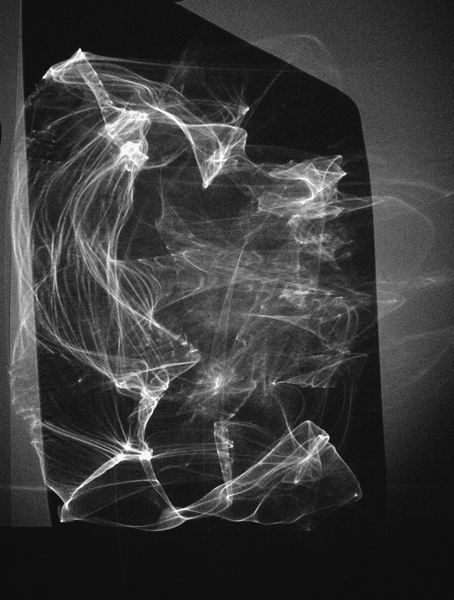
7.6: Nina Sellars, Lumen, 2008–11.
Helen Pynor’s work is equally controversial in its own way. Organs, the all-too-real components of human and animal bodies, are something that we tend to prefer to look away from or see only in sanitized form, wrapped in plastic in a butcher’s shop. Pynor uses them to make beautiful and thought-provoking works of art. For our show she created Liquid Ground 6, inspired by drownings in the Thames, depicting floating garments evoking human bodies, with organs washing about in the middle of them.
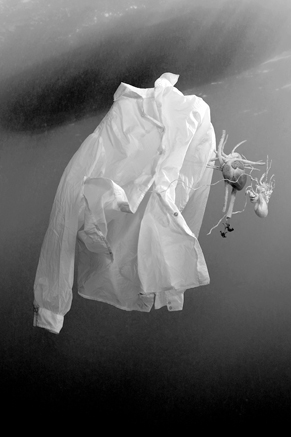
7.7: Helen Pynor, Liquid Ground 6, 2010.
Each piece was a huge collage using photographs made into prints and mounted on glass to give the effect of floating. Her aim, she says, was to make a connection between the body as a cultural thing and the visceral self and to do so in a sensitive way that “avoids either the sensationalism of gore or the clinical neutrality” of medical practice.
The fact that individual organs can be kept alive outside the body means that their integrity must be considered, especially if one believes that consciousness is spread throughout the body. To understand organs fully, Pynor believes that one must take into account the question of the philosophical status of living versus nonliving organisms and the various historical and cultural narratives that surround organisms. She writes: “I’m fascinated by the mystery of our status as biological beings whose bodies are the repository for experience, language, and consciousness in and beyond the central nervous system.”
One of the highlights of the exhibition was Oron Catts and Ionat Zurr’s Pig Wings. Catts is director of SymbioticA, the controversial laboratory established in 2000 at the University of Western Australia, Perth. One of its specialties is tissue engineering, creating entities on the borderline between living and nonliving—“semi-living sculptures.” A husband-and-wife team, Catts and Zurr work on the cutting edge of biology-influenced art, growing things rather than sculpting them. Usually to be found in lab coats, they have replaced their easels with petri dishes to grow different types of tissue from the cells of dead animals. Once the skin has grown they dye it, photograph it, and use it to create extraordinary objects. They are, they say, interested in direct engagement with living tissue sculptures, rather than using traditional representational techniques.
Their Pig Wings project is a meditation on the shape a pig’s wings would take if pigs could fly (see Insert). To make it, the two used stem cells from a pig’s bone marrow, grown into pig tissue on a biodegradable polymer frame. Coated with gold, the tiny wings (4 cm x 2 cm x .5 cm) were exhibited in jewelry boxes. The first two times the pig wings were exhibited, there was also a living version of the wings growing in the gallery. They write, “Wet biology art practices are engaged in manipulation of living systems. [We are] exploring the manipulation of living tissues as a medium for artistic expression.” “Wet biology” means the use of living tissues. In growing cells in order to explore the shape of wings on pigs, they explore the aesthetic as well, following the rule that in nature forms possessing pleasing properties are naturally preferred because they are the most efficient, like beautiful theories in physics.
Catts was much inspired by the Vacanti brothers, who in 1995 engineered the Vacanti mouse, a mouse which looked as if it had a human ear growing out of its back. The “ear” was actually a structure formed by planting cells from cow cartilage in biodegradable mold in the shape of an ear and implanting it under the mouse’s skin. The Vacantis’ aim was to create human organs in the laboratory from the patient’s own tissue so there would be little chance of rejection—groundbreaking research. Catts and Zurr actually worked under Joseph Vacanti and produced Pig Wings at his laboratory in Harvard in 2001.
Catts and Zurr explore “what it is to be human, a quest in which art is going to play a major role.” Their aim is to provide a platform to study ethical issues around life and the incompatibility of the way that science and society deal with it. “The function of art,” says Catts, “is to expose areas of life that we don’t have the proper language to describe,” such as his semiliving forms: what to call them, how to deal with their dignity. He seeks out “areas of incompatibility, zones of discomfort.”
Stelarc was the undisputed star of our exhibition at GV Art, famous for his spectacular performances dating back some forty years. To him, “what connects artists and scientists is technology.” One of his two contributions to our show was a left ear growing on his left arm. To make it, some of his stem cells were seeded into a biodegradable polymer frame shaped like an ear and implanted on his arm in a series of operations, begun in 2007, which are still going on. Eventually a microphone will be inserted into the ear, connected to a Bluetooth system, so that the ear can “hear.” There will also be a receiver in Stelarc’s mouth so that when he opens it a person near him will hear the voice of someone else, who is telephoning him.
Besides the ear, the operation as performance was shown at our exhibition in the form of six stunning color photographs by Nina Sellars, entitled Oblique: Images from Stelarc’s Extra Ear Surgery (see Insert). Sellars’s artwork utilizes drawing, photography, installation, and up-to-date technologies. “In the 21st century we have become captivated by technologies for realms that exist beyond what is normally visible,” she writes. She uses techniques such as medical imaging technology to create exquisite light works. Her giant photographs of Stelarc undergoing surgery ask the question: Who is the artist—the surgeon, the patient, or the photographer?
The photographs—especially vivid in that they were not framed—show the initial operation, in which a scaffold in the shape of an ear is inserted into a hole in Stelarc’s arm. The arm seems almost disembodied, with its gaping hole waiting to receive the microphone. The harsh lighting focused on the arm with everything else fading into darkness is reminiscent of paintings of surgical postmortems hundreds of years ago, lit by candles inserted into the cadaver’s opened body cavity. We staged debates in which two of the photographs were directly behind the speakers. Some of the audience had to look away now and then.
Stelarc’s other piece was Stretched Skin, a huge digital portrait of his own face flattened and floating, like a Mercator projection of the world. Printed on three separate panels, it was exhibited not on the wall but horizontally, 40 cm off the floor, illuminated from above. Many viewers found it one of the most shocking pieces there. For Stelarc, art is a way to explore “what it means to be a body.”
Stelarc pushes the limits of the body, and much of his work is space-age stuff. He has been hung up by hooks through his skin, sported a robotic third arm, and operated a vast metallic spiderlike six-legged walking machine, the Muscle Machine, which was activated by responding to his movements. Bodily extensions of this sort, he asserts, are destined eventually to actually become part of the body. After all, we are only part human. Part of us is already inorganic in that our physiology contains viruses from billions of years ago, made up of inorganic matter.
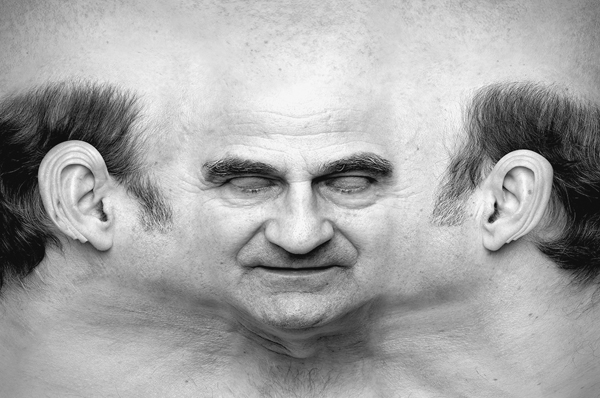
7.8: Stelarc, Stretched Skin, 2010.
This should not surprise us. We live in an age in which organs await transplantation and mechanical parts such as hearts can be inserted into us—even animal hearts. Human eggs can be frozen and then fertilized by sperm that may have also been frozen. Blood transfusions can make my blood into yours, corpses can be cryogenically frozen to be reanimated when a cure for a particular disease is found, and comatose bodies can be kept alive on life support machines. Soon, he says, there will “be no more biological death.” Instead, it will be a question of being disconnected from whatever machine is keeping us alive.
All of these artists are typical of the extremes of science-influenced art. Like practitioners of extreme sports, they push themselves and their art to and beyond limits.
A GOOD NUMBER of people—some 2,800—visited our exhibition on “merging art and science to make a revolutionary new art movement.” The reviews were generally positive. Sally Carter wrote in the British Medical Journal, “This exhibit is an adventure.” Matthew Reisz commented in the Times Higher Education, “Wherever science is leading us, these artists are following and finding powerful ways to address important issues of progress, identity, and what it means to be human.” Katia Sowels of the Independent described the exhibition as “intriguing, because at first glance art and science are generally considered opposites.” Helen Lewis, in the New Statesman, identified a problem that the new movement of science-influenced art has yet to deal with: “Scientists are leading the way—several of these pieces have already been sold to museums or professional bodies—but getting art critics interested is proving harder.” This is apposite. When curators at major museums and galleries agree that science-influenced art is important and meaningful, it will have arrived.
During the exhibition I chaired three debates. The intense give-and-take paints a telling picture of the complex issues underlying this newly emerging art movement: how it should proceed, the role that science plays in the work of artists, how and whether the coming together of art and science should or should not proceed, and what it actually means for artists and scientists to work together. Tiffany O’Callaghan wrote in the New Scientist, “Miller spoke about an emerging third avenue of art in the 21st century, a true convergence of art and science, but the artists were at pains to dissemble his vision,” and indeed on several occasions I found myself the minority voice. She went on, “Perhaps as artists increasingly collaborate with scientists, and head into labs for their technology, the distinction between tools and inspiration will blur.”
The first debate took place on June 8, 2011. It was a warm evening and over a hundred people were crammed into a small room, overflowing into the garden. This debate had a sharp critical edge and spirited discussion, not surprising as the panel consisted of Oron Catts, Nina Sellars, and Stelarc. To start the discussion, I asked whether science-influenced art might prove to be at the forefront of a whole new culture in the twenty-first century. To my surprise, the panelists attacked me for using the words “science-influenced,” which they interpreted as suggesting a hierarchy of disciplines—that science was above art. I replied that artists have always taken their inspiration from outside themselves. In this day and age, science pervades our culture, so it makes sense that artists should use it as a source of inspiration. The panelists were disturbed by what they saw as a lack of symmetry in my remarks, the suggestion that science affects art but not vice versa. I replied that while science-influenced art certainly exists, there are very few examples of art-influenced science, although I am sure this will evolve.
The artists also claimed that they were not so much influenced by science but simply used it like paint in a can. They finally conceded that they were challenged by science. But technology was different.
Oron Catts spoke of the evils of technology and the importance of separating it from science. This is an old refrain dating from the post–atomic bomb days into the 1960s and 1970s—that technology, not science, is responsible for nuclear weapons and the evils of society. Today this stance seems archaic, in light of the blurring of the line between science and technology.
To the audience’s surprise, the panel also insisted on a “dignity of disciplines,” arguing that erasing the line between art and science could lead to scientists producing bad art and artists producing bad science. In other words, art is art and science is science—a position that seems increasingly parochial. The panel went on to argue that scientists think less creatively than artists because of the restrictions on their work imposed by the need to apply for grants. This may apply in the case of scientists who are experimentalists, whose research grants are for a very specific project, but not to scientists who specialize in theory, whose research can range wider than their grant specifies. The panelists seemed to know little of what went on in the world of science outside biology. This held for most of the audience too, the vast majority of whom were artists.
The panelists complained that while they visit scientists in their laboratories and offices, the scientists never visit them. Scientists tend to get lost in their own work and not have time to look outside it. The educational process too often does not give scientists the urge to expand their horizons. The importance of looking into the arts is critical for wide-ranging research.
Art and music can certainly inspire great science. A Bach sonata can help recharge one’s energy to return to what seems an intractable problem. But this is different from being influenced by an artist as a result of the collaboration to such an extent that the scientist changes his view or looks again at his day-to-day research. There is a difference between science-inspired art and science-influenced art, as there is between art-inspired science and art-influenced science. I’m interested in artists influenced by science, not artists inspired by science, “influenced” being stronger than “inspired.”
The body as canvas: ORLAN
Like Stelarc, ORLAN’s canvas is her body. In fact, if anything, the experiments she carries out on it are even more extreme.
Before I even meet ORLAN, her assistant reminds me by email that her name is spelled in capitals. She is a brand. The underlying theme of ORLAN’s work has always been an attack on traditional concepts of female beauty—invented, she says, by men for their own pleasure—and on Christianity, which treats the female body as unclean.
Always controversial, ORLAN had her great epiphany in 1978, when she was thirty-one. She was about to address a symposium on video and performance art when she collapsed and had to be taken to the hospital for emergency surgery for what turned out to be an ectopic pregnancy. She took a video crew to film the operation and insisted on remaining conscious throughout. Looking up from the operating table, she saw light beaming down as if from heaven, and the surgeon standing over her like a priest officiating at a Mass with his assistants around him like fellow celebrants. There and then she realized that surgery, sculpting her own body, was the way to express herself.
ORLAN was always a rebel. At twenty-four she flew in the face of her bourgeois upbringing and changed her name from Mireille Suzanne Francette Porte to what she calls her nom de guerre. At art school she dutifully reproduced sculptures and copied paintings of the masters. “Very boring,” she recalls. She soon turned to avant-garde art and filmmaking.
For her, feminist issues were always paramount, especially in the revolutionary 1960s. She launched herself into performance art early on. In 1964, when she was seventeen, she had herself photographed naked, “giving birth” to an androgynous mannequin. Later she entitled the photograph ORLAN Giving Birth to Her Beloved Self. Like the mannequin, the name ORLAN is neither masculine nor feminine. “I am both man and woman” is her message.
In 1971 she transformed herself into a Catholic icon, exhibiting photographs, videos, and sculptures of herself as “Saint ORLAN,” swathed in swirling fabrics, both living doll and living sculpture. Like the nursing Virgin Mary and Amazons in battle, she has one breast exposed, thus pointing up the hypocrisy of society’s traditional depiction of women as either Madonna or whore.
In 1990 she began a new project, The Reincarnation of Saint ORLAN, involving a series of nine operations to transform her into the precise image of female beauty as depicted by artists, invariably male. The operations are conceived as performances, with the surgeons dressed in outrageous garments designed by Issey Miyake and other top designers. ORLAN is awake throughout, listening to poetry and music, and the entire procedure is filmed and often streamed live. Taking the operating room as her studio, ORLAN directs, sometimes requesting that parts of the procedure be repeated because the surgeon’s gesture is not just as she wants it or because her face is hidden, or requesting that the camera angle be changed. Sometimes the surgeons want to direct. To ORLAN, these operations are artist–scientist collaborations, but with herself in charge. “I must have control over my own body.”
In one operation ORLAN had “beef implants,” bones from a cow, inserted at her temples to suggest the Mona Lisa’s protruding brow. She decorates the implants with colored makeup and glitter.
When I meet her in Paris, ORLAN beams friendliness and warmth combined with a formidable intellect. Her hair, à la Cruella de Vil, is black on one side, white on the other, and she wears gray-rimmed round glasses with yellow earpieces. The implants on the sides of her face accentuate her expressions as she describes her life and work. Her combination studio, living quarters, and office is immense, filling two floors, with most of the ceiling of the ground floor removed. The upper floor has a ramp for accessing books and files, while the ground floor is lined with bookcases filled with books by or about ORLAN and artworks depicting her.
Our conversation quickly turns to her present interest: cells. She is struck by the immortality of cancer cells, which live on even when the body in which they are growing dies. “Cells expand in time and space, like the body,” she says.
She started her recent project, Harlequin Coat, at SymbioticA in 2007. Harlequin in his diamond-patterned suit, the nimble, irrepressible trickster of commedia dell’arte, has always intrigued artists. In his Rose Period, Picasso was entranced by him. Shrouded in mystery, supposedly possessing the secrets of alchemy, Harlequin has the power to become invisible or take other forms. According to some versions, Harlequin can be male or female.
ORLAN’s harlequin coat is a patchwork of diamonds of different skins. ORLAN uses her own skin cells, mixed with those of others—cells from a twelve-year-old female fetus of African origin collected in a biopsy, muscle cells from a marsupial left over from scientific research—together with human blood cells, mouse connective tissue, goldfish neurons, human brain cells, menstrual endometrium, umbilical cord and vaginal cells, together forming an assemblage of skins of different colors, ages, races, and origins. The cells are cultivated in petri dishes set inside diamond-shaped Perspex of different colors. During her surgical procedures ORLAN wears her harlequin’s coat. A bioreactor forms the harlequin’s head.
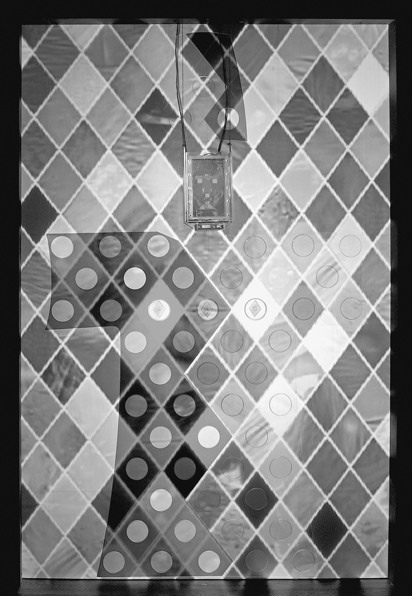
7.9: ORLAN, Harlequin Coat, 2007.
As more of ORLAN’s cells are co-cultured with other cells in the bioreactor, so the installation evolves. Gradually this living material replaces the dead cells in the petri dishes. But this drama, as ORLAN calls it, is invisible, played out inside the bioreactor, in contrast to ORLAN’s other works, in which her body is opened up, revealing everything. “This particular work is caught between the folly of wanting to see and the impossibility of seeing,” she explains.
But how can this be art if the drama is invisible? It differs from visual art in that it is strongly performance-based, but it is art nonetheless. ORLAN gives Jackson Pollock as an example. His art is as much his performance as the painting he makes—the act of painting as a form of visual art.
In Harlequin’s Coat, says ORLAN, “biotechnology is taken out of the laboratory and turned into a spectacle through the commedia dell’arte character of Harlequin and ORLAN’s cells which play an actor’s role, in both the theatrical and the linguistic sense of the word.”
The fluorescent rabbit
The American artist Eduardo Kac works on the borderline between humans, animals, and robots. He calls the products of genetic engineering “transgenic art.” In 1997 he was one of the first to have a microchip implanted in his body, in his case in his ankle, the place where slaves were most often branded.
Kac’s most famous creation is Alba the rabbit, a white rabbit implanted with a green fluorescent protein gene from a type of jellyfish. Like the jellyfish, Alba shone green when exposed to blue light (see Insert).
Roy Ascott, a pioneer of computer art, supervised Kac’s PhD thesis. He is cynical about Kac’s motivation. “Kac’s point of view was that he saw the rabbit as Duchamp’s urinal.” He intended it to shock, to ensure that bioart would never be the same.
The director of the laboratory in France where Alba was born in 2000 was responsible for the experiment and refused to allow Alba to leave. So Kac launched a “Free Alba” campaign, with T-shirts and flags, claiming that his campaign highlighted the complexities of how an artwork is received and the pressures placed on the artist. He set up performances involving himself, the media, and the public “to enact critical views, to make present in the physical world invented new entities (artworks that include transgenic organisms) which seek to open a new space for both emotional and intellectual aesthetic experience.”
A recent work of his, Cypher (2009), includes a DIY transgenic kit, giving everyone the chance to breathe life into their own piece of biological art.
Beauty in asymmetry: Marta de Menezes
Marta de Menezes also interferes with nature, though her works are far more benign. De Menezes works at the intersection between art and biology. In her best-known work, Nature?, she tampers with butterflies’ wings to create asymmetries. The asymmetrical butterflies flutter around a greenhouse.
I met de Menezes in 2009 at a symposium entitled “Einstein, Picasso” in Dortmund and was struck by her seriousness of purpose and expertise in biology, a subject she largely taught herself. De Menezes is Portuguese. She studied fine arts at the University of Lisbon, intending to become a high school art teacher. Then she went to Oxford. She found university life highly stimulating and began collaborating with scientists.
The artists who have most influenced her, she says, are Joseph Beuys, Gerhard Richter, and John Cage, all of whom defined their own paths, breaking away from the norm.
In 1998, de Menezes came across a paper in the journal Nature about scientists at the University of Leiden who were making studies of butterflies. To explore the formation of wing patterns, they altered the factors affecting wing appearance by interfering with normal butterfly development, but without modifying any genes. De Menezes was thrilled at the idea of creating art using live butterflies, so she approached them and began a collaboration. The following year she produced Nature?, which was first exhibited at Ars Electronica in Linz in 2000. For this she inserted a very thin needle coupled to a heat generator into the cocoons of the butterflies. When the butterflies emerged, one wing had a modified pattern, while the other was normal. These asymmetrical wing patterns had never before occurred in nature. As the genes were unchanged, the next generation of butterflies had normal, symmetrical wing patterns. This was a work of art with a limited lifespan. De Menezes displayed her butterflies in a specially constructed room.
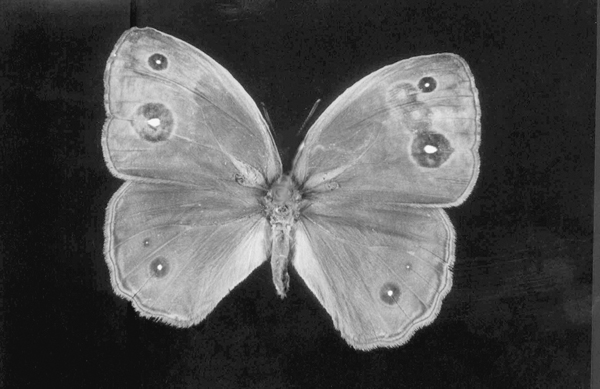
7.10: Marta de Menezes, Nature?, 1999.
“My methodologies in creating artworks and pursuing ideas have been deeply shaped by my interactions with scientists,” she says. “With them I learned to plan my actions, discuss the ideas, and be as clear as possible in explaining them to others so that my projects can grow. With scientists I learned to keep a lab book to make sure I can retrace my steps. I learned to work on my own project and simultaneously share objectives, to work collaboratively.”
De Menezes sees Nature? as straddling the frontier between art and science, though ultimately it is art. “I always refer to my work as art, not science-influenced art. It is art in every part of it and very clearly not science. I’m a science-influenced artist that makes art with a strong scientific content,” she says. Although her work relates to scientific considerations, it is not science per se. Rather than advancing science, it is influenced by science.
Biology-influenced art in New York: Suzanne Anker
As Suzanne Anker, doyenne of biology-influenced art in New York, puts it, “Art uses every other discipline as its data bank.” Dynamic and bursting with energy and enthusiasm, Anker is chair of the fine arts department at the School of Visual Arts. Her Aha! moment came in 1988 when she was working on bronze sculptures of tree forms, egg forms, and flower forms which she linked with man-made objects such as funnels and soccer balls. In one piece, she attached a kaleidoscope to a vase. When she looked through the kaleidoscope, the circular form of the vase produced an image akin to images of cells seen through a microscope. Looking through biology books for interesting images of cells, she realized that the image she had created was similar to chromosomes, the DNA structures found in a cell.
She decided she wanted to have her own chromosomes mapped. At the time it was unclear what this meant and her health insurer became concerned. They asked why she was doing it, to which she replied, “Chromosomes can’t tell me who I am, but they can tell me what I am.” Unimpressed, they dropped her health insurance. It took her a year to construct a three-dimensional model from the two-dimensional images of her chromosomes. Anker realized that she had finally found the connection between art and science that she had dreamed of as a teenager.
Born in 1946 in Sheepshead Bay, Brooklyn, Anker studied chemistry at Brooklyn College. The subject had always intrigued her—“how parts fit together, the alchemy involved in mixing stuff.” The mathematics, however, was too much and she changed to her other interest, art.
At the time, Brooklyn College was a center of abstract art. Anker worked under one of America’s foremost Abstract Expressionists, Ad Reinhardt, and found him a great inspiration. “It was the first time I saw the philosophical underpinnings of art, not just mimesis, rather art that had to do with social and spiritual values.” She immersed herself in the 1960s art scene, hanging around Max’s Kansas City, the Manhattan watering hole of choice for Robert Rauschenberg, Roy Lichtenstein, and Donald Judd. The back room was reserved for Andy Warhol and his entourage and the Velvet Underground regularly played there.
Overwhelmed by this exalted company, Anker concluded that it was “too hard to be an artist in New York City,” although she continued to harbor the desire. Having graduated, married, and moved to Boulder, Colorado, she did a master of fine arts degree at the University of Colorado. At the time she was drawing, printmaking, experimenting in papermaking, and casting forms in paper pulp. Requests from New York regularly arrived to include her work in exhibitions. Finally, in 1975, she agreed. Her first group show was at the Martha Jackson Gallery. She found herself going back to New York so often that she finally took the plunge, ended her marriage, and stayed.
Anker began to “think about manipulating nature and the way in which science is about discoverable truths about nature and how it can be adjusted to its transformative capabilities.” She planned a show on the intersection between art and genetics, at the time not exactly a hot topic or even one well known to artists or scientists. A friend at Fordham University in the Bronx asked Anker to curate a show on the campus. The show, entitled Gene Culture: Molecular Metaphor in Contemporary Art, took place in 1994 and was the first exhibition devoted entirely to the intersection of art and genetics.
Around that time Anker met Dorothy Nelkin, a sociologist at New York University known for her studies on the relationship between science and society. Anker and Nelkin shared an interest in the way that the ethical and social issues of the emerging biology-influenced art affected both scientists and artists, in particular artists working in laboratories trying to represent life forms and molecules not known in nature, or even actually producing these molecules, as would become the case in synthetic biology.
As the twenty-first century dawned there were giant leaps in biology, such as the human genome project. The double helix structure of the DNA molecule was by then iconic. While Anker incorporated it into paintings, sculptures, and installations, Nelkin looked into its significance for society.
Their work led to a book, The Molecular Gaze: Art in the Genetic Age, published in 2003 by Cold Harbor Laboratory Press (associated with Cold Harbor Laboratory, where James Watson, the co-discoverer of DNA, was director). The book had an excellent reception but sadly Nelkin died shortly before it came out.
After many years of writing and practicing on the borderline between biology and science, Anker has concluded that “anything to do with the natural world is art and science.” For her, “bioart or sci-art is an umbrella term that has no clear-cut geographical area, nor is it media-dominated.” Hers is not an anything-goes view, however, akin to an artist declaring that a spaghetti-like structure represents string theory. There must be artistic integrity, as Anker shows in her creations in which organisms are clearly organisms. Examples range from plants grown under LED lights to Zoosemiotics, tiny chromosome sculptures laid out in identical pairs, which were exhibited at the Getty Museum in Los Angeles in 2001 (see next page). This is not merely figurative art. A strong sense of fantasy pervades. “That’s because artists believe in magical thinking,” she says with a smile.
Like many artists involved in biology, Anker is self-taught and knows enough of the concepts to use them effectively in her art. “My interest is not in being a rookie scientist, but a professional artist.” She has never worked directly with a scientist. At the School of Visual Arts, her students take biology courses at the Museum of Natural History in which they learn to use high-tech equipment. In this way she hopes they will produce high-grade biology-influenced art.
She has also installed a wet lab, the Nature and Technology Lab, for students to carry out actual experiments to use as the basis for artwork. “Things that are going on in labs are very inspiring—dangerous, but inspiring. In the art world there has been too much of a gravitational shift toward entertainment and popular culture when there are some really fabulous things being done in science. Artists are well poised to enter that dialogue.”
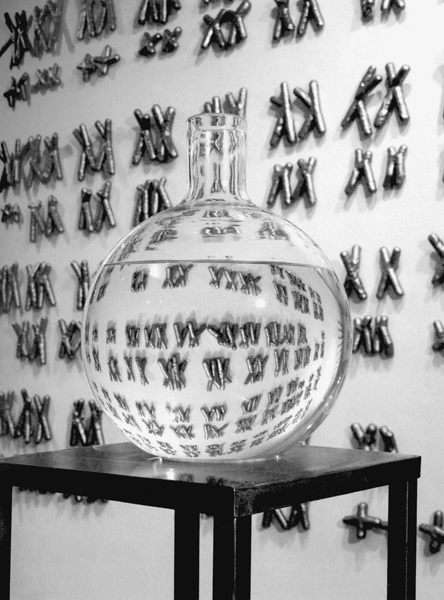
7.11: Suzanne Anker, Zoosemiotics (Primates, Frog, Gazelle, Fish), 1993 (detail). Installation at the J. P. Getty Museum, Los Angeles, California.
Anker is interested in extemporizing from nature, using highly technical approaches such as rapid prototyping and other techniques for producing actual objects. The creative lever is to “present the technology with problems it can’t do. That way there’s an upgrade in the ways in which one can transform matter.” Unity must come from a fusing not only of art and science, but technology, too.
Anker makes frequent visits to science laboratories. She agrees that artists seem to get more out of a collaboration than scientists. But artists “can bring other things to scientific practice. Artists don’t work according to scientific methods, they shoot from the hip”—they can be freer in their approach to a problem. They “can come into a lab from the outside and spark a scientist’s mind with a chance remark, perhaps coaxing the role of serendipity in scientific research.”
In 2007, Anker recalls, the artist Mark Dion, whose work focuses on ecological issues and our perception of nature, was asked to create an installation at the Natural History Museum in London to commemorate the three hundredth anniversary of the great naturalist Linnaeus. Many of the scientists involved were angry that funds were going to a mere artist. So Dion decided to do something that an “artist might think up, but not a scientist.” He attached flypaper to the top of his car and drove at high speed down a large street in London. Then he sent the flypaper to a laboratory, where scientists found three new species of insect. After that, says Anker, “the scientists changed their tune.”
She turns the conversation to interdisciplinarity, to the importance of overlap among art, science, and technology. A course has just been implemented at the School of Visual Arts which is taught by an artist, a designer, and an architect—a very encouraging development. “Going back into one’s ghetto doesn’t work any longer.”
Speaking up for nature: Brandon Ballengée
Brandon Ballengée is another New York artist who steers clear of the art ghetto. Ballengée is an artist, activist, and ecological researcher. He uses nature as his palette, recording the ups and downs of ecosystems as civilization impinges on woodlands, streams, and oceans. This is a brand-new field of art, still trying to find its way, often resulting in little more than banal photographs of icebergs. Ballengée uses actual science in making his artworks. For him art and science are one.
A tall New Yorker who sports a cap and neatly trimmed triangular stubble sideburns, Ballengée speaks with calm assurance. Born in 1974, he grew up in central Ohio with nature as his playground. As a teenager he witnessed the incursion of lumber companies, followed by housing developments. One by one streams disappeared to be replaced by sewage systems, and shopping malls sprang up. “Much of my early work dealt with this sense of loss and was infused with the classical theme of man versus nature. The earth, once again, became my studio.”
At the Art Academy of Cincinnati, Ballengée studied both fine arts and biology. He was particularly inspired by Ernst Haeckel, the nineteenth- and early-twentieth-century German artist and naturalist famous for his drawings of animals in his book Kunstformen der Natur (Art Forms in Nature). “While Haeckel drew, he learned the organism’s functions,” says Ballengée.
Ballengée is particularly concerned about the decline of the frog, toad, and salamander populations and the increasing numbers of deformities. “Amphibians,” he says, “are a ‘sentinel’ species, the environmental ‘canaries in the coal mine.’” The walls of Ballengée’s Manhattan studio are covered in drawings of frogs made using cigarette ash and coffee and fixed with rabbit-skin glue and latex paint to give a distinctive texture. Sometimes he cuts up the drawings and reassembles the parts.
Ballengée also uses “clearing and staining,” a technique by which he makes a preserved specimen completely transparent while dyeing certain bones and tissues. The delicate and almost magical result, as in the piece DFA186:Hades, is achieved using a mix of over ten chemicals and dyes (see Insert). As Ballengée puts it, referring to Joseph Beuys, the subversive twentieth-century German artist, it’s a “Beuysian idea. The materials that artists use can have alchemical properties.” He exhibits the preserved amphibians in all their glittering colors, or photographs them. The beautiful images are both art and scientific studies, a crossover from Ballengée’s collaboration with scientists as working partners.
One of Ballengée’s ongoing concerns is with the continuing deterioration of biosystems in the Gulf of Mexico after the BP Deepwater Horizon oil spill in 2010, a disaster that continues to devastate marine and bird life. His interest in frogs “relates to ecological problems not necessarily caused by chemical impurities in the water, as well as by injuries caused by changes in the environment. The wetlands have become ecologically stressed as a result of chemicals, nutrient runoff, lawn runoff, garbage, predators, and parasites.” Part of his work involves “citizen scientist” activities, taking people into wetlands to collect species, assist in biodiversity surveys, and clean up. He has taken inner city children to polluted urban rivers where they see amazing amphibians living among the broken glass and plastic bottles, which they begin to look on with disgust. This is the way, says Ballengée, that “eco-artists [can] transform the society and environment in which we live.”
Ballengée currently runs the Nature and Technology Lab at the School of Visual Arts. Certain art dealers, he says, don’t consider his work genuine art, a not unusual response to artworks that involve science. He has found a few dealers who will sell it. “Frogs sell better in Europe,” he says. He has had several exhibitions in Britain. And private collectors and museums sometimes buy actual specimens. The art critic and activist Lucy Pippard describes him as one of the “‘eco-artists’ whose art may be unrecognizable as art because it achieves a social function.”
The “mad scientist”: Joe Davis
Joe Davis is not concerned with social function, activism, or political agendas. “If only the government would support truly innovative, fascinating art, rather than vaguely imaginative, mostly placid already-been-done disappointments currently sucking up the allotments,” he says. Well put! He makes this remark after lamenting that he himself receives no governmental support. A hard-drinking, fast-talking, peg-legged artist and motorcycle mechanic from Mississippi, Davis is a one-man publicity machine. In addition to braggadocio regarding past girlfriends and how much alcohol he can consume, he likes to tell the story of how thirty years ago he walked into the MIT Center for Advanced Visual Studies and demanded to speak with the director. When he was refused, he trashed the receptionist’s desk, after which the police were called. But the fracas ended amicably. He stayed on as a researcher. “They called the cops and never let me go.”
With his bizarre outfits and peg leg, like a Caribbean pirate of old, Davis is a walking work of art. He has been known to use his hollow metal leg to open beer bottles, or to play it like a bugle in his local bar. Amazingly, Davis actually went to college. Having been expelled from various high schools and colleges, he ended up at an experimental college in Oregon and did a degree in creative arts, then lectured in architecture at MIT for ten years. He also has an honorary PhD from the Bauhaus University in Weimar, Germany. Davis’s father, a chemist, often talked to him about the latest scientific developments. But Davis was also fascinated by art and was torn between the two.
For the past twenty years he has been an unpaid researcher at MIT’s department of biology and, as of three years ago, a researcher at Harvard Medical School, also unpaid. He likes to talk about his precarious living situation. He has had numerous evictions for nonpayment of rent and often has to sleep in his office or his car.
For Davis, genes are his medium. From scientists at MIT and Harvard, he learned how to synthesize DNA and insert it into the genome, the repository for biological information in an organism. The information in the genome is encoded in the DNA, which contains instructions for maintaining and building the organism.
Davis’s big idea was that “DNA can encode any information, not just genetic sequences.” He dubs it an infogene. In 2000 he created a work of symbolic art which he called Microvenus. For this he used the bacteria E. coli, which exists in everyone’s gut and can survive extreme temperatures and radiation, even those of outer space. To make Microvenus, Davis created a visual icon—the letter Y with a vertical line drawn through the middle, representing the female genitalia. This is also, coincidentally, an ancient Germanic rune for life. He then digitalized it and, with the help of scientists, created a string of nucleotides—biological molecules, the building blocks of DNA—out of this string of zeroes and ones. He inserted the new molecule, imprinted with the Microvenus symbol, into E. coli, which multiplied it into billions of cells each carrying the same imprint.
Davis’s objective was to amplify information on the plaque sent up in the Pioneer 10 spacecraft in 1972 which showed images of a nude male and female. Only the male’s genitalia were shown, not the female’s. Davis looks forward to NASA transmitting the digitization of Microvenus to correct the oversight. Meanwhile, galleries refused to show Microvenus, citing the dangers of biologically engineered bacteria. Might they be superviruses? Microvenus was eventually displayed in 2011 at Ars Electronica, inside a pressurized containment vessel.
Davis also equipped ballet dancers with a transmitting device inserted into the crotch of their tutus, as a cross-disciplinary project involving artists, architects, and electrical and mechanical engineers to build a contrivance that recorded the sounds of their vaginal contractions and beamed them into space. The sounds were transmitted for several minutes from MIT’s Millstone Hill radar station until the United States Air Force shut the transmission down. Like many biology-influenced artists, Davis has a sense of humor.
Another of his creations is Bacterial Radio, based on the crystal radio. The simplest type of radio receiver, the crystal radio has no batteries or connections to external energy sources. The basic circuit uses a crystal detector that converts radio signals into electrical signals that can be listened to through headphones.
To grow his Bacterial Radio, Davis put E. coli and other organisms into a petri dish in which he had laid out a circuit. As the E. coli grew, they produced chemical reactions that generated an electrical current that could be heard through earphones. Basically, the Bacterial Radio is alive. Davis points out that nature is more efficient than industry, so it makes sense to make use of biological processes.
At the 2012 Ars Electronica Davis won the top prize, the Golden Nica, in the hybrid art category, for Bacterial Radio—for the concept, that is, as the radio didn’t work. Biosafety regulations prohibited the use of recombinant materials outside the laboratory. So, for the first time in his research, Davis tried to grow a circuit by metallizing nonrecombinant bacteria, to no avail.
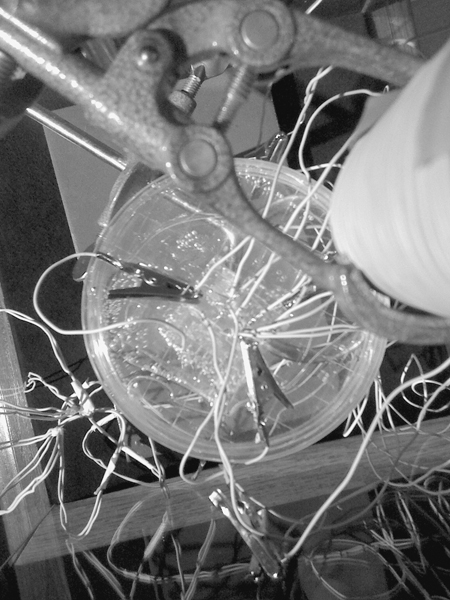
7.12: Joe Davis, Bacterial Radio, 2011.
Davis is regularly invited to address science departments and symposia, though he finds that “often I speak a language that nobody understands.” He feels passionately that artists should not pander to market tastes. “Artists should create things that hold an idea, no matter what it is. That’s what art is.”
The firefly brain: Jun Takita
Jun Takita is another outsider, dreaming unimaginable dreams. A highly contemplative Japanese artist, he is inspired by Zen gardens which depict water using only sand. “The concept of a garden is in your head. The Zen monk watches over it.”
Born in Tokyo in 1966, as a child Takita was enthralled by natural landscapes and deeply affected by urban development leading to the death of plants, animals, and insects. “Most of all, the little fireflies that I loved were disappearing.” He studied arts at Nihon University, then moved to Paris and did his master’s degree at the École Nationale d’Art, while also reading books on science, “because without science there is no way to visualize the world.” In Paris he studied under the unconventional Polish artist and architect Piotr Kowalski, who looked for ways to express natural phenomena through the senses. His projects included explosions, electronic devices, plant growth, and gravity. After he died in 2004, Takita took over his large garden.
With the help of physicists and geophysicists Takita has continued Kowalski’s work exploring gravity and how we keep our balance. He muses about whether there could be a connection between gravity and light, as both penetrate everything. He is particularly interested in bioluminescence, the power of living organisms to produce light, and what that tells us about our relationship to nature. Very few species glow in the dark. Among them are fireflies, glow worms and Dinoflagellata, a kind of plankton which has characteristics belonging to both plants and animals.
Takita believes that “artistic action” is necessary in the modern world where “nostalgia for paradise [and] the impact of a technocratic future” clash, a world where even fireflies may become extinct. Through his art he tries to create a landscape that is “a direct extension of the body, of my body, the landscape of a dreamed reality.”
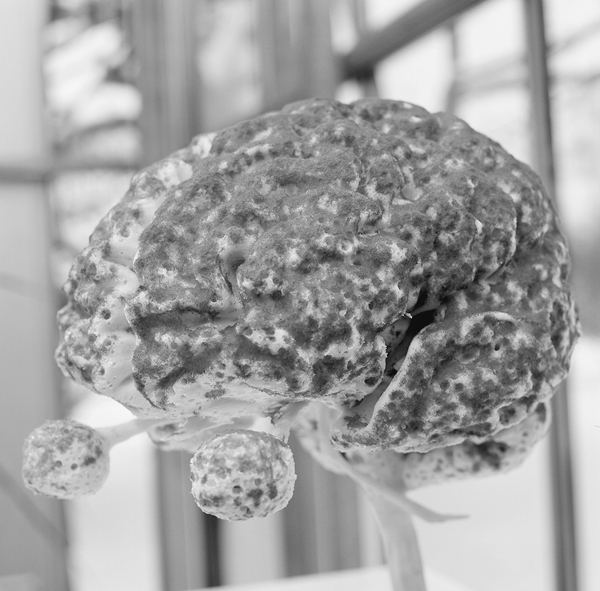
7.13: Jun Takita, Light, only Light, 2004.
To further this aim, he produced a work which he called Light, only Light. First he had an MRI scan made of his brain, then used a computer to convert the two-dimensional scan into a three-dimensional sculpture. Then he turned to scientists at Leeds University’s Centre for Plant Sciences. He was looking for bioluminescent moss; they developed a new, genetically engineered strain of it for him, an excellent example of the way in which art can affect science. Takita then covered the sculpture of his brain with the green, bioluminescent moss. He exhibited the result at the exhibition Sk-interfaces in 2008, at the FACT art center in Liverpool. The brain is a glowing garden, which has to be looked after like an ordinary garden. Takita says it was a singular experience for him to see a living replica of his own body, going “against the conventions which hold that there is a barrier separating the inside and the outside of the body.” He was especially enthralled by the brain’s crumpled surface, “in which light creates a strange relief.” Whereas a garden is usually regarded as a place that catches light, Takita’s gardens create light. His Light, only Light is a beautiful, intriguing, and rather disturbing work.
Takita’s musings on the nature of gardens have led him to conclude that there is a vast difference between the traditional garden, which each viewer sees differently, and a garden of transgenic organisms “acting as plants and nonplants,” emitting light, transgressing against the laws of nature. When he sees the light he has himself created, he thinks, “this is the expression of man’s impossible desire to possess light.”
Sadly, to exhibit his work in Liverpool, Takita had to use ordinary nontransgenic moss with no glow. The British authorities were afraid of unleashing a pandemic if they exhibited transgenic organisms in a public place. As well as the moss-covered brain, Takita also showed photographs of the original in all its glowing glory. It was exhibited at the top of a lighthouse at the Article biennale of electronic art in 2008 in Stavanger, Norway, and at Sk-interfaces in Luxembourg between 2009 and 2010.
Takita’s thought-provoking pieces are exhibited worldwide but cannot be sold due to the biogenic material. Photographs, however, sell quite well. In Japan, he says, they are considered art and media, rather than art and biology, which shows the importance of media art and the wider context in which these artworks are seen.
Takita has a gut reaction that tells him when the work is completed, he says. Aesthetics is “beauty in proportion,” which is what he seeks. Another aesthetic moment for Takita is that of discovery, when it occurs to him “how to do the work.” “Process rather than result” is the basis of his method.
Some people find biology-influenced art shocking and question whether it is deliberately intended to shock—whether it is “shock art.” Takita’s moss-covered brain may be shocking but this, he says, is very far from his intention.
Half-woman, half-horse:
Marion Laval-Jeantet and Benôit Mangin
Quite a few biology-influenced artists, such as Stelarc and ORLAN, experiment on their own bodies. Even closer to the edge is the collective Art Orienté Objet—Marion Laval-Jeantet and Benoît Mangin—who inject themselves with horse blood. “We are interested in blurring the boundaries between species and between art and science,” they say. They call their experiment-performance May the Horse Live in Me.
The first performance took place at the Kapelica Gallery in Ljubljana, Slovenia, in September 2011. Laval-Jeantet had previously spent many months with scientists receiving preparatory injections of horse immunoglobulin in order to ward off allergic reactions. Mangin, her husband, joined her in the process. This period of “process” involved a communication ritual with the horse, in which Laval-Jeantet walked around with it wearing prosthetic hooves.
On the day itself, Laval-Jeantet tells me, as she lay down to receive the first injections of horse blood, “I had the feeling of being extra-human, I was not in my usual body. I was hyper-powerful, hyper-sensitive, hyper-nervous, and very diffident, the emotionalism of an herbivore. I could not sleep. I probably felt a bit like a horse.” By the end of the performance, a high proportion of her blood content was from the horse.
Afterward, Laval-Jeantet had samples of her hybrid blood extracted and freeze-dried. Two series of artworks have been produced in the form of engraved aluminum cases containing blood samples. None are for sale. What adds to their value is that the experiment cannot happen twice, the curator of the show, art theorist Jens Hauser, tells me. He writes, “[Their performance] explores the new hybrid organisms, and in the utopian, artistic, poetic way anticipates the possible forms of coexistence between animals and humans.” In 2011, Ars Electronica awarded them a Golden Nica for hybrid art—an appropriate category.
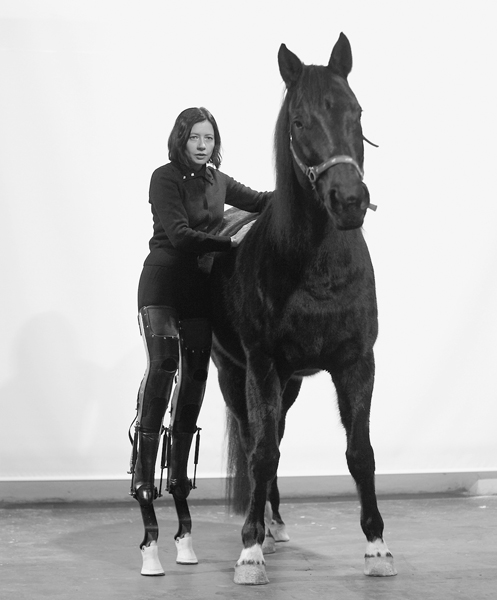
7.14: Marion Laval-Jeantet and Benôit Mangin, May the Horse Live in Me, 2011.
A very attractive couple, Laval-Jeantet and Mangin were both avidly interested in art and science—especially Laval-Jeantet, whose parents were scientists—but both opted to study art. They met in an art history class, and Laval-Jeantet convinced Mangin they should work together. “After all,” she told him, “no scientists work alone.” They went on a degree spree, obtaining degrees in anthropology, art, psychology, and biochemistry, and began working together as Art Orienté Objet. Their theme was to use their own bodies as objects of study in experiments on the forefront of biotechnology. Laval-Jeantet had done this as a child when she picked up a wasp, found it squishy, and out of curiosity bit it. Both participated in secret initiation rites of the Baka pygmies in Gabon, from which they suffered severe liver ailments for four years afterward.
Laval-Jeantet and Mangin think a great deal about the relationship between art and science. “Why restrict one’s mind?” Laval-Jeantet practices what she preaches, having worked as an artist, an anthropologist, and a psychologist. They see scientists as trapped within disciplines, while an artist can offer a different way of looking at a particular piece of research. The pair recall working in a biochemistry lab where scientists tried to explain their work in a way that bordered on the dumbed-down. Each scientist thought his own explanation was the best. Finally they asked the scientists to draw pictures to show what they did. All drew drastically different images and were unable to explain their role in the research project in simple terms even to their own colleagues. It seemed they didn’t really understand the conceptual basis of what they were doing. The artists’ request for a visual representation had forced the scientists to look again at their work.
Nevertheless the two disagree with scientists who claim that collaborating with artists widens their thinking. “We know that’s bullshit,” says Mangin.
The pair see a role for the artist in our changing world. “Space for freedom is shrinking in our society and the artist has the responsibility to take this into account. The artist must know about science and be able to transmit scientific information to inform the populace. The artist is a go-between.” They can’t yet envision the long-term effects of their experiment. They “like the idea that it’s never-ending” and could affect surgical methods which involve animal matter. Their horse blood transfusion work is a reminder that standard surgery often involves animal parts—pigs’ hearts, for example.
Thus biology-influenced art pushes the boundaries of our everyday world and makes us look more closely at what is around us—while also fascinating us, shocking us, and occasionally making us laugh.